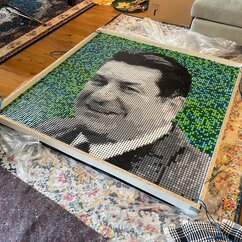
“Locus” is an artwork in acrylic on oligo tubes, created by Philipp Dexheimer in 2025 to mark the IMP's 40th anniversary. The mosaic is created from building blocks of scientific discovery: each of its 10,000 hand-painted oligo tubes contains DNA used in experiments at the Vienna BioCenter.
Together, these oligo tubes form a portrait of Max Birnstiel - the scientific nucleus from which the Vienna BioCenter emerged. What began as a single institute under Max Birnstiel's leadership has evolved into one of Europe’s most vibrant and influential life science hubs.
One of Max Birnstiel’s outstanding scientific achievements was the isolation of the ribosomal DNA (rDNA) locus from Xenopus oocytes: a breakthrough that, with time, revealed how genes responsible for ribosome production are organised and regulated. The sequence of this very rDNA locus Birnstiel first isolated is depicted in the background of this artwork, with the four colours representing the four bases of DNA.
In the mosaic, a single red oligo tube stands out: It contains the 5.8S rDNA sequence that Birnstiel described and serves as a visual homage to the IMP logo’s iconic red dot. The discovery of this locus offered a first glimpse into the architecture of genetic information in an era when genome organisation was still a mystery.
The artist
Philipp Dexheimer is a molecular biologist and artist who earned his PhD at the IMP exploring gene expression, animal development, and protein folding. For his creative work, he takes inspiration from the concepts and molecular aesthetics of nature, transforming scientific insight into art that captures the essence of life. Dexheimer's work highlights the shared curiosity that fuels both the pursuit of knowledge and artistic ingenuity.
Inspiration: the Birnstiel Legacy
As a scientist and research manager, Max Birnstiel was a lifelong advocate of egalitarian work culture, sharing knowledge, and enabled future generations of scientists. In this spirit, the Max Birnstiel Foundation was created in 2017. It supports initiatives such as the Vienna BioCenter Summer School; the International Birnstiel Award for Doctoral Research in Molecular Life Sciences; and the Talents for Future training programme to empower students from underprivileged backgrounds. The IMP organises a distinguished lecture series in Max Birnstiel’s name since 2009.
Max L. Birnstiel (1933-2014)
Max Luciano Birnstiel was a pioneer of molecular biology and the founding director of the IMP. Birnstiel was the first scientist to purify a single eukaryote gene in 1966 and made one of the earliest discoveries of a gene enhancer element in 1980.
Max Birnstiel studied physical chemistry at the ETH Zurich, where he also earned a PhD. He then joined Caltech for postdoctoral research, meeting his wife Margaret Chipchase, a biochemist. Returning to Europe, he founded his own group at the new MRC Epigenetics Research Group in Edinburgh in 1963.
Birnstiel and his colleague Hugh Wallace purified eukaryotic genes encoding ribosomal RNA and histones by isopycnic ultracentrifugation, years before cloning techniques existed in what was the first gene isolation in history. The scientists also discovered that ribosomal RNA genes in the frog Xenopus laevis are arranged in tandem repeats within the nucleolus organiser, identifying the nucleolus as the site of ribosomal RNA production.
In 1972, Birnstiel returned to Switzerland as director of the University of Zurich’s Institute of Molecular Biology II, where he led pioneering research for 16 years. His lab isolated vertebrate histone and tRNA genes, discovered how histone mRNA 3′ ends are formed, and was among the first to characterise eukaryotic gene promoters—work that brought him wide recognition and numerous awards.
In the 1980s, Birnstiel spearheaded the establishment of the Research Institute of Molecular Pathology (IMP) of Boehringer Ingelheim and Genentech. As founding director, he recruited top scientists, established core facilities and a Scientific Advisory Board, and fostered the institute’s collaborative culture inspired by Europe’s leading molecular biology centres.
In the early 1990s, he initiated a partnership with the University of Vienna, thereby laying the foundation for the Vienna BioCenter and the launch of the Vienna BioCenter PhD Program in 1993. Even after retiring in 1996, Birnstiel remained deeply involved through co-founding the biotech company Intercell (later Valneva), serving on boards, and keeping close ties to the IMP.
References
First isolation of eukaryote gene
Wallace, H., and Birnstiel, M. L. (1966):
Ribosomal cistrons and the nucleolar organizer.
Biochem. Biophys. Acta 114, 296-310.
Gene enhancer element
Grosschedl, R., and Birnstiel, M.L. (1980):
Spacer DNA sequences upstream of the T-A-T-A-A-A-T-A sequence are essential for promotion of H2A histone gene transcription in vivo.
Proc. Natl. Acad. Sci. USA 77(12):7102-6.
Formation of histone mRNA 3′ ends
Strub, K., Galli, G., Busslinger. M, and Birnstiel, M.L. (1984):
The cDNA sequences of the sea urchin U7 small nuclear RNA suggest specific contacts between histone mRNA precursor and U7 RNA during RNA processing.
EMBO J. (12):2801-7.



